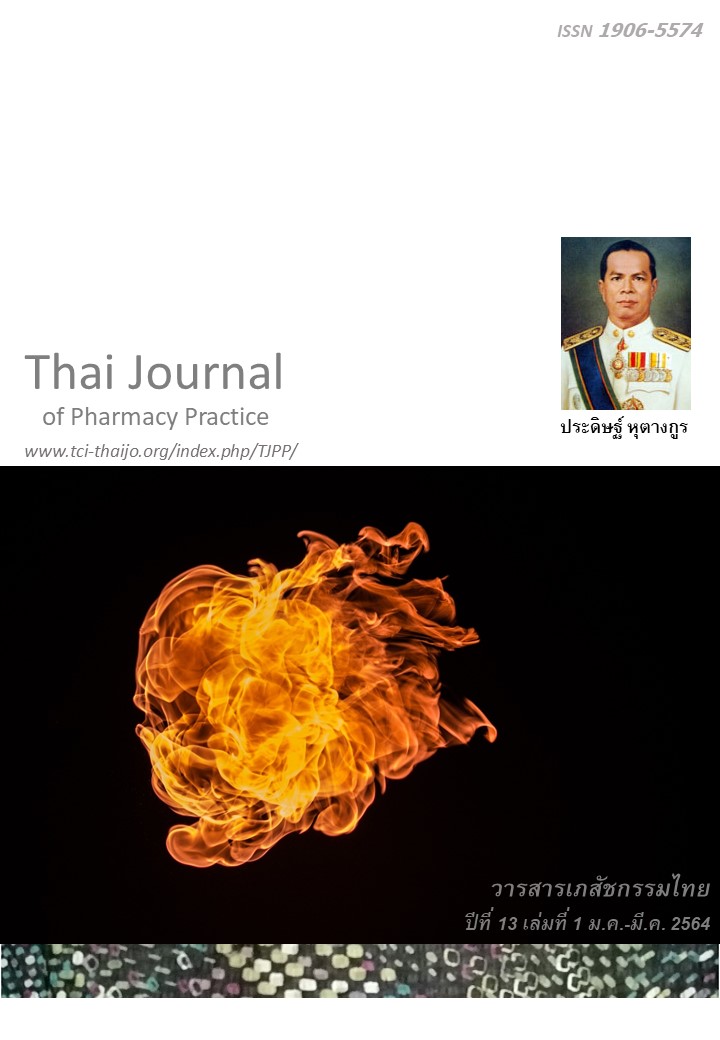การจัดการความเสี่ยงโดยใช้ Failure Mode And Effects Analysis ในลูกโซ่ความเย็นวัคซีนของอำเภอสนม จังหวัดสุรินทร์
Main Article Content
บทคัดย่อ
วัตถุประสงค์: เพื่อประยุกต์ใช้เครื่องมือ Failure Mode and Effect Analysis (FMEA) ในการจัดการความเสี่ยงของลูกโซ่ความเย็นวัคซีนในอำเภอสนม จังหวัดสุรินทร์ วิธีการ: การศึกษาครั้งนี้เป็นการวิจัยเชิงปฏิบัติการ ทีมสหสาขาวิชาชีพ 12 คนใช้การจัดการความเสี่ยงเชิงรุกตามขั้นตอนของ FMEA ได้แก่ 1) การเขียนผังกระบวนการทำงาน 2) การระบุข้อบกพร่อง ความเสี่ยง และผลที่เกิดจากข้อบกพร่องในแต่ละขั้นตอน 3) การระบุค่าความน่าจะเป็นที่จะเกิดข้อบกพร่อง ค่าความรุนแรงของผลกระทบ และความสามารถในการค้นพบความเสี่ยง 4) การคำนวณค่า RPN (risk priority number) และการจัดลำดับ 5) การวางมาตรการป้องกัน/ลดความเสี่ยง ผลการศึกษา: กระบวนการลูกโซ่ความเย็นวัคซีนของอำเภอสนมมี 8 กระบวนการหลัก ความเสี่ยงที่อาจจะเกิดขึ้นได้มี 56 รายการ ความเสี่ยงพบมากที่สุดในกระบวนการเก็บรักษาวัคซีนที่หน่วยบริการ 13 รายการ (ร้อยละ 23.21) มีความเสี่ยงเพียงรายการเดียวที่มีความรุนแรงในระดับ 5 คือ ความเสี่ยงเรื่องการแพ้วัคซีนแบบรุนแรง ความเสี่ยง 8 รายการมีค่า RPN มากกว่าหรือเท่ากับ 25 โดยสูงที่สุดที่ RPN=40 ในความเสี่ยงเรื่องการสัมผัสอุณหภูมิไม่เหมาะสมของวัคซีน multiple dose ในระหว่างการให้บริการ และการไม่ตรวจสอบวัคซีนก่อนการให้บริการ หลังการร่วมกันวิเคราะห์หาสาเหตุ วางมาตรการลด/กำจัดความเสี่ยงที่ผู้ปฏิบัติเห็นว่าสามารถนำไปปฏิบัติได้จริง และประเมินความเสี่ยงซ้ำอีกครั้ง พบว่าแนวโน้มค่า RPN ลดลง ทั้ง 8 รายการ สรุป: การจัดการความเสี่ยงกระบวนการลูกโซ่ความเย็นด้วยเครื่องมือ FMEA เป็นการจัดการความเสี่ยงเชิงรุก ที่อาจช่วยป้องกันหรือลดความเสี่ยงที่อาจจะเกิดขึ้นในกระบวนการทำงานได้
Article Details
ผลการวิจัยและความคิดเห็นที่ปรากฏในบทความถือเป็นความคิดเห็นและอยู่ในความรับผิดชอบของผู้นิพนธ์ มิใช่ความเห็นหรือความรับผิดชอบของกองบรรณาธิการ หรือคณะเภสัชศาสตร์ มหาวิทยาลัยสงขลานครินทร์ ทั้งนี้ไม่รวมความผิดพลาดอันเกิดจากการพิมพ์ บทความที่ได้รับการเผยแพร่โดยวารสารเภสัชกรรมไทยถือเป็นสิทธิ์ของวารสารฯ
เอกสารอ้างอิง
World Health Organization. Immunization in practice: Module 3: The cold chain. Geneva: World Health Organization; 2004.
National Vaccine Institute. Operating manual for vaccination staff 2018. Bangkok: Amarin Printing & Publishing; 2018.
World Health Organization. New measles surveillance data for 2019 [online]. 2019 [cited May 3, 2019]. Available from: www.who.int/immunization/news room/measles-data-2019/en/
Nuandaisri P, Rukaphan K, Jongsuwiwatwong V. Monitoring of cold chain temperature systems in the vaccine stores at district and district levels [master thesis]. Songkhla: Prince of Songkla University; 2011.
Techathawat S, Warinsathien P, ChamroenSuk A, Thammapornphon P. Survey of quality of vaccines and cold chain systems of public health agencies in the public health area 12 districts in 2004. Journal of Disease Control 2006; 32:20-30.
Rao S, Naftar S, Baliga S, Unnikrishnana B. Evaluation awareness practice and management of cold chain at the primary health care center in coastal South India. J Nepal Pediatric 2012; 32:19-22.
AramSopha K, Aramopa S, Pharmaceutical and Consumer Protection Group Phutthaisong Hospital. The development of cold chain quality systems for immunization of Phutthaisong district. Journal of the Government Pharmaceutical Organization 2013; 39:3-7.
Sripanphan N, SinghChangchai P, Limarunrueng S. Risk management in providing vaccines for primary care units Pattani Province. Al-nur 2011; 6:101-15.
Kartoglu U, Milstien J. Tool and approaches to ensure quality of vaccines throughout the cold chain. Vaccine 2014; 13:843-54.
Nelson C, Froes P, VanDyck A, Chavarria J, Boda E, Coca A, et al. Monitoring temperatures in the vaccine cold chain in Bolivia. Vaccine 2007; 25:433-7.
World Health Organization. WHO guidelines on quality risk management. In: WHO Expert Committee on specifications for pharmaceutical preparation. Forty seventh Report. Geneva: World Health Organization; 2013. p. 61-92.
Rakesh R, Joe B.C, Mathew G. FMEA analysis for reducing breakdowns of a sub system in the life care product manufacturing industry. Int J Eng Scci Inn 2013; 2:218-25.
Nagamine J, Williams M. Quality tools: root cause analysis (RCA) and failure modes and effects analysis (FMEA). Hospitalist 2005; 9: 19-22.
Magnezi R, Hemi A, Hemi R. Using the failure mode and effects analysis model to improve parathyroid hormone and adrenocorticotropic hormone testing. Risk Manag Healthc Policy 2016; 9:271-74.
Jiang Y, Jiang H, Ding S, Liu Q. Application of failure mode and effect analysis in a clinical chemistry laboratory. Clin Chim Acta 2015; 48:80-5.
Najar A.V, Ghane H, Ebrahimipour H, Nouri G.A, Dadpour B. Identification of priorities for medication safety in the neonatal intensive care unit via failure mode and effect analysis. Iran J Neonatol 2016; 7:28-34.
Turner N, Laws A, Roberts L. Assessing the effectiveness of cold chain management for childhood vaccines. J Prim Health Care 2011; 3: 278-82.
Lloyd J, Lydon P, Ouhichi R, Zaffran M. Reducing the loss of vaccines from accidental freezing in the cold chain: The experience of continuous temperature monitoring in Tunisia. Vaccine 2015; 33:902-7.
Thaweerat S, Kahawong B, Boonsang K, Saenkhot S, Wirasathien L, Yoopan N, et al. Development of vaccine delivery method of hospitals in Nakhonnayok province. Journal of the Office of DPC 7 Khon Kaen 2018; 25:103-14.
Lee Y.B, Haidari L. The importance of vaccine supply chains to everyone in the vaccine world. Vaccine 2017; 35:4475-9.
Pumtong S, Duangchan P, Wirasathien L, Yoopan N, Limdul P. Knowledge, attitude and behavior of health care personnel towards management of vaccine and cold chain in National health security office zone 4-Saraburi. Isan Journal of Pharmaceu- tical Sciences 2013; 9:17-30.


